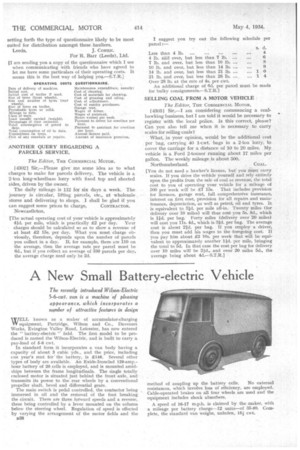A New Small Battery-electric Vehicle
Page 52

If you've noticed an error in this article please click here to report it so we can fix it.
The recently introduced Wilson-Electric 5-6-cwt. van is a machine of pleasing appearance, which incorporates a number of attractive features in design
WELL known as a maker of accumulator-charging VV equipment, Partridge, Wilson and Co., Davenset Works, Evington Valley Road, Leicester, has now entered the " battery-electric " field. The first model to be produced is named the Wilson-Electric, and is built to carry a pay-load of 5-6 cwt.
In standard form it incorporates a van body having a capacity of about 3 cubic yds., and the price, including ene year's rent forthe battery, is £146. Several other types of body are available. An Exide-Ironclad 129-amp.hour battery of 29 cells is employed, and is mounted amidships between the frame longitudinals. The single totally enclosed motor is situated just behind the front axle, and transmits its power to the rear wheels by a conventional propeller shaft, bevel and differential gears.
The main switch is pedal controlled, the contactor being immersed in oil andthe removal of the foot breaking the circuit. There are three forward speeds and a reverse, these being controlled by a lever mounted on the column below the steering wheel. Regulation of speed is effected by varying the arrangement of the motor fields and the method of coupling up the battery cells. No external resistances, which involve loss of efficiency, are employed. Cable-operated brakes on all four wheels are used and the equipment includes shock absorbers.
A speed of 16-17 m.p.h. is claimed by the maker, with a mileage per battery charge-12 units—of 35-40. Complete, the standard van weighs, unladen, 15i cwt.




























































































